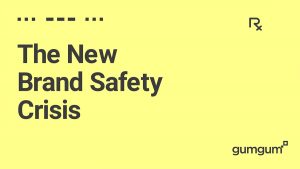 GumGum, an artificial intelligence company with deep expertise in computer vision, released market research findings, conducted in concert with Custom, Digiday Media’s creative content agency, examining the brand safety crisis impacting the advertising industry. The in-depth study investigates how brands, agencies and publishers are addressing this issue while also examining the ways to help identify and reduce exposure to unsafe content.
GumGum, an artificial intelligence company with deep expertise in computer vision, released market research findings, conducted in concert with Custom, Digiday Media’s creative content agency, examining the brand safety crisis impacting the advertising industry. The in-depth study investigates how brands, agencies and publishers are addressing this issue while also examining the ways to help identify and reduce exposure to unsafe content.
“When brands are damaged, we all suffer,” said Phil Schraeder, President and Chief Operating Officer of GumGum. “With brand safety now reaching epidemic levels, we need a comprehensive understanding of how these issues occur in the first place and impact the brand ecosystem. Based on our findings, we are able to identify ways to limit brand safety exposure, with computer vision as a leading solution.”
In addition to providing tips for prevention of and recovery from brand safety crises, the report also aims to identify what communities are at risk, specific risk factors and other harmful effects.
Key findings of the report include:
- 75 percent of brands reported at least one brand-unsafe exposure in the past year with 10 percent reporting “regular” exposure and 70 percent saying they’re taking brand safety seriously or very seriously, yet only 23 percent of brands have employed solutions for longer than two years and 15 percent don’t use any at all.
- While 44 percent of brands and agencies grapple with brand-unsafe imagery and 32 percent wrestle with brand-unsafe video, only 15 percent use computer vision to scan visual content before placement.
- While 47 percent of brand respondents noted social media blowback in response to a brand safety incident, and 25 percent said they’d gotten negative press, only 13 percent said they had lost revenue.
- 59 percent of publishers surveyed believe direct relationships are the most effective way to ensure a brand’s ads are circulating in the appropriate environments.
- Other remedies by publishers include site blacklisting (31 percent), followed by ads.txt (24 percent) and keyword detection (22 percent).
- LinkedIn was viewed as the most brand-safe platform by those surveyed while Facebook was the least safe. Facebook’s prominent role in last years’ fake news epidemic has tarnished its brand safety reputation. Surprisingly, despite its persistent brand safety episodes, YouTube was ranked a little safer than publisher sites.
Source: GumGum

You must be logged in to post a comment Login